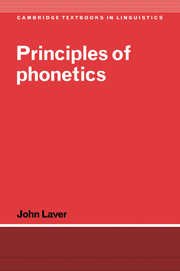Book contents
- Frontmatter
- Contents
- List of figures
- List of tables
- Preface
- Acknowledgements
- Introduction
- PART I General concepts
- 1 The semiotic framework
- 2 The relationship between phonetics and phonology
- 3 Accent, dialect and language
- PART II The analytic framework
- PART III Initiation and phonation
- PART IV Linear segmental analysis
- PART V Articulatory co-ordination and phonetic settings
- PART VI Temporal, prosodic and metrical analysis
- PART VII Principles of transcription
- PART VIII Conclusion
- Envoi
- Appendix I The phonetic alphabet of the International Phonetic Association
- Appendix II Index of languages
- References
- Index of names
- Subject index
2 - The relationship between phonetics and phonology
Published online by Cambridge University Press: 05 June 2012
- Frontmatter
- Contents
- List of figures
- List of tables
- Preface
- Acknowledgements
- Introduction
- PART I General concepts
- 1 The semiotic framework
- 2 The relationship between phonetics and phonology
- 3 Accent, dialect and language
- PART II The analytic framework
- PART III Initiation and phonation
- PART IV Linear segmental analysis
- PART V Articulatory co-ordination and phonetic settings
- PART VI Temporal, prosodic and metrical analysis
- PART VII Principles of transcription
- PART VIII Conclusion
- Envoi
- Appendix I The phonetic alphabet of the International Phonetic Association
- Appendix II Index of languages
- References
- Index of names
- Subject index
Summary
The point has now been reached where it is necessary to develop in more detail the concept of a number of levels of analysis of the material of speech production. This will be used throughout the rest of the book as a basic framework. The major part of the chapter will then focus on the discussion of the phonological level of analysis, and its relationship to phonetic analysis. A number of basic phonological concepts will be introduced, amongst which those of the phoneme and the allophone, together with the idea of phonological structure and system, are the most central.
The acoustic level
The initial level of analysis of speech production, closest to the physics of the original speech material itself, is the acoustic level. Two speech events can be considered to be different at the acoustic level, in either quality or timing, when an instrumental acoustic analyser of any sort can register discernible evidence of the difference. Two repetitions by a single speaker of vocal material that is linguistically and paralinguistically identical are most unlikely to be acoustically exactly the same. Two such utterances from two different speakers are virtually certain, except by the most random operation of chance, to be acoustically different (Perkell and Klatt 1986).
This level of analysis is the subject matter of acoustic phonetics, and will not be the principal concern of this book. Many good introductions to acoustic phonetics exist, including Baken (1987), Borden and Harris (1980), Fry (1979) and Ladefoged (1962).
- Type
- Chapter
- Information
- Principles of Phonetics , pp. 26 - 54Publisher: Cambridge University PressPrint publication year: 1994



